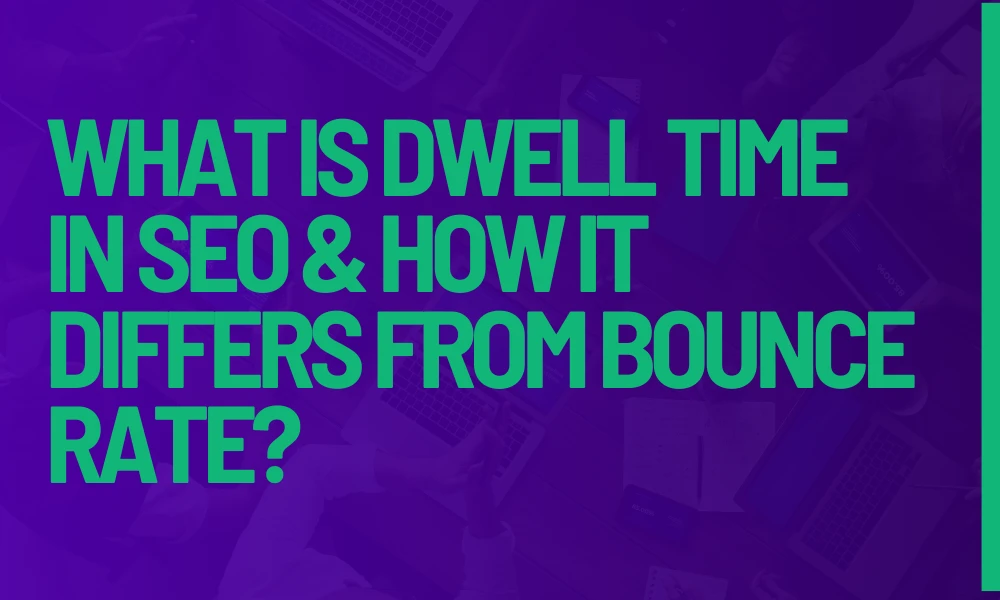Do you want to know what is Dwell Time in SEO and how it differs from Bounce Rate? You’re in the right place.
Dwell Time is an important SEO metric that indicates how long a user spends on a webpage after clicking on it from search engine results, before returning to the search engine. This metric reflects the user’s engagement and satisfaction with the page’s content, as a longer Dwell Time generally suggests that the user found valuable information.
Though Google does not officially confirm using Dwell Time as a ranking factor, it’s widely believed to influence SEO because it provides indirect insights into content quality and relevance.
Following topics will be covered in this post:
- Dwell Time Components
- How Dwell Time Impacts SEO
- Bounce Rate: What It Is and How It’s Measured
- Key Differences Between Dwell Time and Bounce Rate
- Why Both Metrics Matter in SEO
- How to Improve Both Dwell Time and Bounce Rate
RELATED
- How to Know If Backlinks are Helping or Hurting Your Website?
- Why Does it Take So Long to Get Traffic on New Blogs, Even With Good Content, and SEO?
- How to Ensure Backlinks are Placed on High Quality Sites?
- How to Optimize Your Blog for Voice Search
- How to Add Schema Markup to a Website
Don’t Miss! Discover thousands of easy to customize themes, templates, CMS products, plugins, and more. Let’s Go!
01. Dwell Time Components
There are three main components of Dwell Time:
- Entry from a Search Engine: The user must enter the webpage through a search engine result.
- Duration on Page: The total time the user spends engaging with the page.
- Return to Search: The user eventually returns to the search results.
A high Dwell Time suggests that the page effectively meets the user’s needs, possibly indicating good content quality, readability, and relevance. Conversely, a short Dwell Time may signal that the page is not meeting user expectations, prompting a quick return to search results.
02. How Dwell Time Impacts SEO
Although not officially a ranking factor, Dwell Time impacts user satisfaction, indirectly influencing search engine rankings. If users consistently stay longer on a page, it suggests that the page is well-aligned with search intent, potentially increasing the page’s authority in search results.
For this reason, Dwell Time optimization through quality content, easy navigation, and mobile optimization is recommended as a best practice for SEO.
03. Bounce Rate: What It Is and How It’s Measured
Bounce rate is a separate, widely-used metric in SEO and web analytics. It refers to the percentage of users who visit a page and leave without interacting with any other pages on the website. In other words, a user “bounces” when they view just one page and exit, with no additional clicks or interactions on the site.
There are two components of Bounce Rate:
- Single Page Visit: The user only views one page on the website.
- Exit Without Interaction: The user leaves without further exploring the site.
Unlike Dwell Time, bounce rate doesn’t consider the time spent on a page. A high bounce rate does not necessarily mean low engagement. For example, a user may read an article fully but leave after reading because they got the information they needed, leading to a high bounce rate even with a satisfactory experience.
Related: How to View Bounce Rate on Google Analytics 4 (GA4)
04. Key Differences Between Dwell Time and Bounce Rate
Below are the key differences between the Dwell Time and Bounce Rate.
| Aspect | Dwell Time | Bounce Rate |
|---|---|---|
| Definition | Time spent on a page before returning to search results | Percentage of single-page visits with no interaction |
| Measurement | Calculated as a time interval (implicit) | Calculated as a percentage |
| Purpose | Indicates relevance and engagement from search results | Indicates overall page engagement across site |
| Impact on SEO | Indirect impact on SEO through user satisfaction signals | Mixed impact, depending on site type and content |
| Behavior Indicated | User may have found valuable content | May suggest either satisfied or unsatisfied experience |
05. Why Both Metrics Matter in SEO
Both Dwell Time and Bounce Rate offer insights into user behavior but serve different purposes:
- For Content Quality: High Dwell Time generally reflects well on content, as users who stay longer are likely to be engaged. A high Bounce Rate, however, might signal a need to encourage users to explore other pages, especially for eCommerce or information-heavy sites.
- For Search Intent Alignment: Dwell Time can be a good indicator of how well a page aligns with user intent. Bounce Rate, on the other hand, is more useful for understanding on-site engagement but requires context, as high Bounce Rates can also indicate satisfaction, depending on content type.
06. How to Improve Both Dwell Time and Bounce Rate
Following are some ways to improve both Dwell Time and Bounce Rate:
- Content Quality: Ensure that content is high-quality, aligns with search intent, and provides in-depth answers.
- User Experience (UX): A mobile-friendly, fast, and intuitive design can improve both metrics by enhancing the user’s journey.
- Internal Linking: For Bounce Rate, use internal links to encourage users to explore more content, reducing the likelihood of single-page exits.
By optimizing both Dwell Time and Bounce Rate strategically, SEO practitioners can improve user experience, increase user satisfaction, and create a positive impact on search rankings.
If you like this post then don’t forget to share with other people. Share your feedback in the comments section below.
Also Read






Leave a Reply